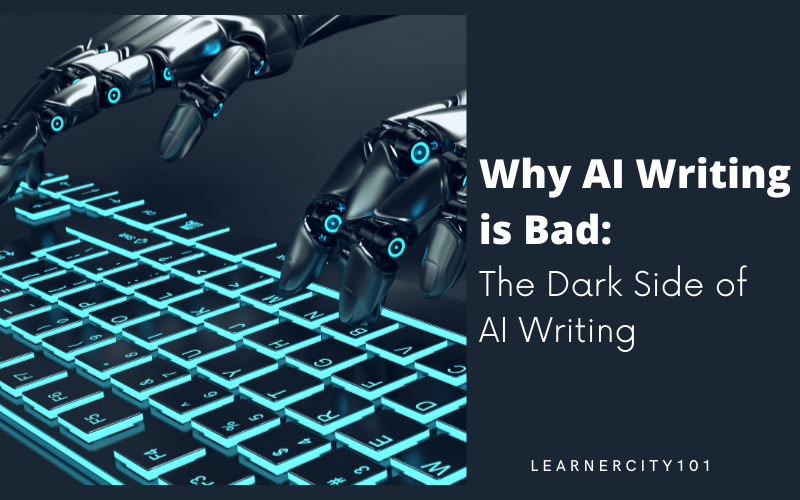Why AI Writing is Bad: The Dark Side of AI Writing
The advent of artificial intelligence has transformed numerous industries, and the world of writing is no exception. AI writing tools promise efficiency, productivity, and convenience.
Apart from this some people always talk about the drawbacks of AI writing. The common question arises “Why AI writing is bad?” AI writing can lack emotional depth, foster plagiarism, compromise quality, displace human writers, perpetuate bias, and raise privacy concerns.
In this article, we delve into the darker side of AI writing, shedding light on why it can be detrimental.

The Dehumanization of Content
AI, despite its remarkable abilities, lacks emotional intelligence. It can churn out words and sentences, but it struggles to infuse content with genuine emotion and creativity. This dehumanization of content poses several problems:
- Emotionless Output: AI-generated content often lacks the emotional depth that human writers can convey. This deficiency can affect the connection between content and its audience.
- Creativity and Authenticity: AI writing tends to rely on patterns and data, often resulting in formulaic content. It can be challenging to produce truly unique and authentic pieces that resonate with readers.
- Uniformity: The widespread adoption of AI writing tools can lead to a flood of content that looks and sounds similar, diminishing diversity in writing styles and voices.
Plagiarism and Ethical Concerns
Plagiarism & ethics are the most important things to consider in AI writing. The machine can produce a lot of articles within minutes or even in seconds. It consumes articles from the web and then produces an article based on it’s feed.

It can be part of plagiarism & ethical concern is a must. It is kind of taking notes from lots of different types of sources, but it cannot write a creative one.
- Detecting Plagiarism: AI-generated content can make it challenging to detect plagiarism, as it can rephrase and rearrange existing information, making it appear original.
- Ethical Implications: The use of AI to produce content without proper attribution or consent raises ethical dilemmas. Is AI-generated content truly the creation of its users, or is it more like borrowing from a vast database?
- Misuse Examples: Real-world cases highlight the misuse of AI-generated content, from academic plagiarism to fraudulent product reviews.
Quality and Accuracy Issues
AI writing tools have limitations when it comes to understanding context and ensuring accuracy:
- Contextual Understanding: It is common for AI to struggle with grasping the complexity of context, resulting in content that does not fully align with the message intended.
- Misinformation and Errors: Inaccurate or misleading information can easily slip through AI-generated content, contributing to the spread of false information.
- Human Oversight: The importance of human editors in ensuring the quality and accuracy of AI-generated content cannot be overstated.
Bias and Discrimination
AI writing tools have inherent biases present in their feeding data, which can perpetuate societal prejudices:
- Biased Training Data: Biases in AI training data can result in content that reflects and amplifies existing stereotypes and prejudices.
- Ethical Responsibility: Developers and users of AI writing tools have a responsibility to identify and mitigate bias in content production.
Privacy and Data Security
The collection and use of personal data by AI writing tools raise significant privacy concerns:
- Data Collection: AI writing tools often require access to vast amounts of personal data, raising questions about consent and data security.
- Misuse of Information: The misuse of personal information collected by AI tools can lead to privacy breaches and even identity theft.
- Regulatory Measures: The need for robust regulations to safeguard user data and ensure ethical AI writing practices is paramount.
The Future of AI Writing
It’s crucial to strike a balance between its benefits and drawbacks:
- Continued Growth: AI writing technology will likely continue to evolve and improve, offering new possibilities and challenges.
- Balancing Act: Striking a balance between human creativity and AI-driven efficiency is key to responsible content production.
- Responsible Practices: Encouraging ethical and responsible use of AI writing tools is essential to harness their potential without compromising quality, authenticity, or privacy.
Conclusion
In the end, AI writing undoubtedly offers numerous advantages in terms of efficiency and productivity. However, we must remain vigilant and critical of its darker side.
The dehumanization of content, plagiarism concerns, quality issues, biased information, privacy, and ethical dilemmas all call for careful consideration and responsible practices in the world of AI writing.
By addressing these challenges, we can harness the potential of AI writing while preserving the integrity and authenticity of the content we create.







